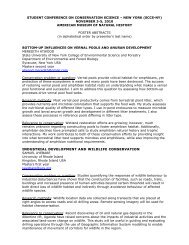Genetics, Genomics, Genethics - American Museum of Natural History
Genetics, Genomics, Genethics - American Museum of Natural History
Genetics, Genomics, Genethics - American Museum of Natural History
You also want an ePaper? Increase the reach of your titles
YUMPU automatically turns print PDFs into web optimized ePapers that Google loves.
M. Netolický et al.: The circumbinary dusty disk around the hydrogen-deficient binary star υ Sagittarii 831160251401202010015F [Jy]80χ 260104052008 9 10 11 12 13λ [μm]Fig. 3. Spectrum <strong>of</strong> υ Sgr taken with VLT/UTs (points with errorbars),the IRAS LRS (solid line), and SED <strong>of</strong> the best visibility fit model(dashed line). The 30% <strong>of</strong> extra flux <strong>of</strong> the IRAS LRS comes from thewider FOV <strong>of</strong> the IRAS spectrograph.Table 3. Parameters <strong>of</strong> the model <strong>of</strong> the best fit <strong>of</strong> the visibility data andestimated uncertainties. Some parameters are poorly constrained andlack an error bar (see Sect. 3.4 for further details).ParameterValueR in [AU] 6.0 +0.5−1.5i50 ◦+10◦−20 ◦α 2.0 +0.3−0.3β 0.7h 100 [AU] 3.5 +2.0−1.5log(M d /M ⊙ ) −3.5M am.C /M d 0.6 +0.2−0.4adopted the sublimation limit <strong>of</strong> 1500 K for all the models. Wealso kept the outer radius <strong>of</strong> the model grid to R out = 100 AU,which corresponds to the observed diameter <strong>of</strong> 400 mas. This isfully consistent with the image taken with VLT UT telescope,whose shows a perfect Airy pattern, which FWHM is approximately225 mas at 8.7 μm.The geometry <strong>of</strong> the disk is defined by α, β, h 100 , R in ,theinclination i, together with the total mass M d <strong>of</strong> the dust and itscomposition. The fitting proceeded in two steps: in the first step,we focused on finding the best brightness distribution on the sky,i.e. concentrating on visibilities alone, which are influenced bythe geometry <strong>of</strong> the dusty envelope. In the second step, based onthe best models fitting the visibilities, we tried to find the best fit<strong>of</strong> the SED, taking particular care to reproduce the 10 μm silicatefeature.The evaluation <strong>of</strong> the quality <strong>of</strong> the visibility fit was made byusing the reduced χ 2 calculated with the standard equation:χ 2 = 1 nn∑ (V obs,i − V model,i ) 2,i=1σ i2where V obs,i is the observed visibility, V model,i the model visibilityinterpolated to the same wavelength as the one <strong>of</strong> the observedvisibility, and σ i the estimated error <strong>of</strong> the visibility. The parameters<strong>of</strong> the best model are shown in Table 3. The correspondingSED is shown in Figs. 2 and 3. The image <strong>of</strong> the disk given bythe best model is shown in Fig. 6. The fit <strong>of</strong> the observed visibilitiesis shown in Fig. 5.00 20 40 60 80 100 120 140 160 180P.A. [deg]Fig. 4. The χ 2 as a function <strong>of</strong> PA for several models that provide bestvisibility fits.From the analysis <strong>of</strong> the computed models we can put thefollowing constraints on the parameters <strong>of</strong> the model:– R in : the inner radius <strong>of</strong> the dusty envelope is one <strong>of</strong> the mostsensitive parameters. We find that, by using the visibilitiesfit, R in = 6.0 +0.5−1.5AU. This value is fully consistent withthe estimated size <strong>of</strong> the binary inside the disk, whose upperlimit for the semi-major axis is 1.9 AU as mentioned inSect. 1. The other constraint on the inner radius comes fromthe temperature distribution, close to the lower limit <strong>of</strong> R in ,the amount <strong>of</strong> the dust, which is above the sublimation limittemperature, is rapidly growing. Taking this into account, weconclude that the inner rim <strong>of</strong> the dusty disk is defined by itssublimation radius rather than by the binary orbit. However,the binarity <strong>of</strong> the source inside the disk can influence thedisk morphology, but our models cannot include this feature.– α, β, h 0 : the constraints on the morphology <strong>of</strong> the objectare not so strong. The α parameter is not defined very welland it provides satisfactory fits for reasonable values typicallyranging from 1.8 to 2.4. Similarly, the low values <strong>of</strong> βprovide equally good fits, although we can firmly excludeany model with β>1.0, which means that the dusty disk<strong>of</strong> υ Sgr does not flare much. This can be indirect evidence<strong>of</strong> a Keplerian disk. This can also be seen as evidence <strong>of</strong> aself-shadowed puffed-rim disk (for discussion <strong>of</strong> the effects<strong>of</strong> different geometries see Dullemond & Dominik 2004),a geometry not handled by our version <strong>of</strong> the MC3D code.Indeed, such geometry strongly enhances the near-IR flux <strong>of</strong>the SED, a part not well-fitted by the model. Our simulationsgive the limits for the scale height h 100 = 3.5 +2.0−1.5 AU.– i: the inclination <strong>of</strong> the dusty envelope is one <strong>of</strong> the mostinteresting parameters <strong>of</strong> our model. If we assume that thedust envelope lies in the same plane as the binary, we putsome constraints on the mass <strong>of</strong> the binary system. We findan inclination i = 50 ◦+10◦−20◦, which is consistent with the constraintsmentioned in Koubský et al. (2006). Because theheight scale h 100 is not defined well and because it is verydifficult to distinguish between the flux coming from the innerrim <strong>of</strong> the disk and the “upper” surface in the mid-IR,since the disk is optically thin, it would be very hard to determinethe inclination <strong>of</strong> the dusty envelope better, even witha uv space that is more densely covered.– PA: as seen in Fig. 4, there is a clear minimum <strong>of</strong> χ 2 forthe PA <strong>of</strong> 80 ◦+10◦−5. This orientation is almost perpendicular◦
















